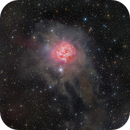Good morning, team.
I’d like to start a discussion about the faintest objects that can be captured under heavily light-polluted skies, such as those in Bortle 8/9 zones.
My primary imaging location is in West London, where the sky brightness ranges from approximately 18.26 (according to LightPollutionMap estimates) to 18.6 (based on my own measurements). To combat light pollution, I use narrowband imaging. Initially, I worked with an OSC camera paired with 6nm Ha/OIII filters but have since upgraded to 3nm Ha/OIII/SII and LRGB filters with a mono camera.
Using the OSC camera and an L-Pro filter, I’ve had moderate success imaging objects like M51, M81 and M82.
With the mono camera and 3nm Ha/OIII filters, I managed to capture Sh2-129 and Ou4 with nearly 24 hours of OIII integration. I was pleasantly surprised to detect some dust and faint structures using LRGB filters near the Seahorse Nebula as well. While the final image incorporates supplemental LRGB data captured under Bortle 4 skies, I’ve also experimented with processing Bortle 8/9 data alone, with some interesting results.
Given these conditions (assuming the more optimistic estimate of 18.6 for sky brightness), do you think it’s feasible to attempt imaging the Integrated Flux Nebula (IFN) near Polaris with LRGB filters and mono camera?
Also, what’s the faintest object you’ve successfully captured from similarly bright city skies?
Looking forward to hearing your thoughts and experiences!
P.S.: I know, I know… I should bite the bullet and travel to darker skies to get better signal with shorter total integration time.
--
Konstantin
I’d like to start a discussion about the faintest objects that can be captured under heavily light-polluted skies, such as those in Bortle 8/9 zones.
My primary imaging location is in West London, where the sky brightness ranges from approximately 18.26 (according to LightPollutionMap estimates) to 18.6 (based on my own measurements). To combat light pollution, I use narrowband imaging. Initially, I worked with an OSC camera paired with 6nm Ha/OIII filters but have since upgraded to 3nm Ha/OIII/SII and LRGB filters with a mono camera.
Using the OSC camera and an L-Pro filter, I’ve had moderate success imaging objects like M51, M81 and M82.
With the mono camera and 3nm Ha/OIII filters, I managed to capture Sh2-129 and Ou4 with nearly 24 hours of OIII integration. I was pleasantly surprised to detect some dust and faint structures using LRGB filters near the Seahorse Nebula as well. While the final image incorporates supplemental LRGB data captured under Bortle 4 skies, I’ve also experimented with processing Bortle 8/9 data alone, with some interesting results.
Given these conditions (assuming the more optimistic estimate of 18.6 for sky brightness), do you think it’s feasible to attempt imaging the Integrated Flux Nebula (IFN) near Polaris with LRGB filters and mono camera?
Also, what’s the faintest object you’ve successfully captured from similarly bright city skies?
Looking forward to hearing your thoughts and experiences!
P.S.: I know, I know… I should bite the bullet and travel to darker skies to get better signal with shorter total integration time.
--
Konstantin

